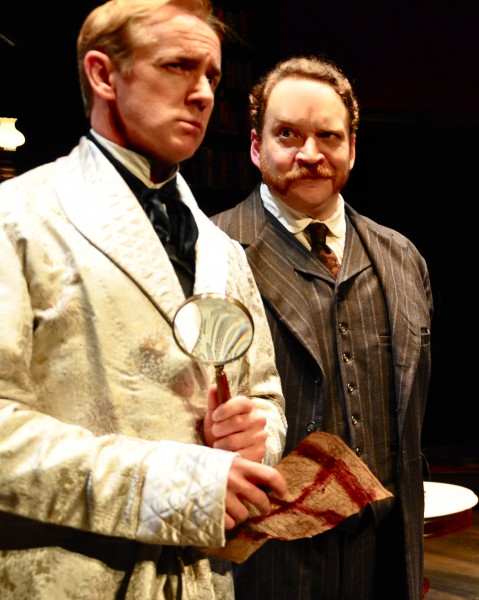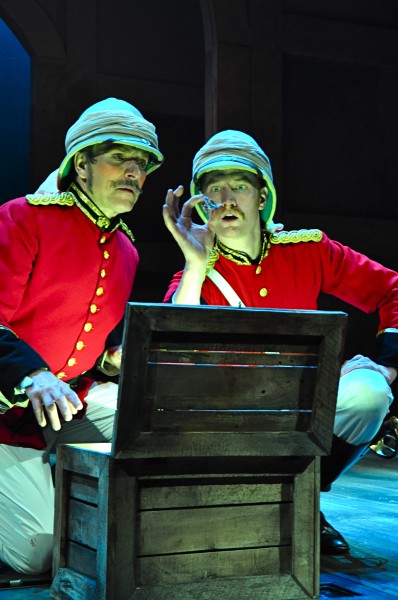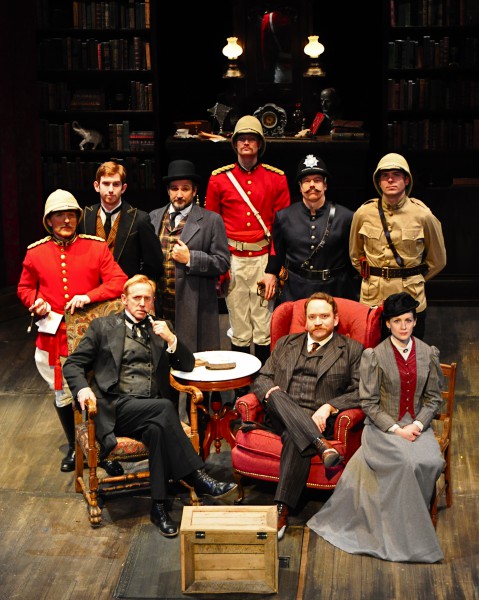Out of the Mists, a Forgotten Sherlock: PICT’s ‘Crucifer of Blood’

This Sherlock (David Whalen) is doing it the proper Victorian way, with an optical scanning device circa the 1880s, and Dr. Watson (Justin R. G. Holcomb) approves.
In this play, before the action begins or a word is spoken, fog rolls in silently. Pittsburgh Irish and Classical Theatre has turned on the fog machine, which serves as a way-back machine. As mists envelop the still-dark stage, it is a sign that we are going back in time. The Crucifer of Blood opens in the Rebellion of 1857 in British-ruled India, where three soldiers commit a dastardly deed amid the fog of war. Then we move to the fogs and opium dens of London in the 1880s, where Sherlock Holmes (David Whalen) tries to penetrate a mystery born from the consequences of the deed.
It’s a trip back to the dark ages of our modern era—and back in time theater-wise. The Crucifer of Blood, by Paul Giovanni, debuted on Broadway in 1978, collecting four Tony nominations. Despite the play’s initial splash—it also ran for more than a year in London, and inspired a made-for-TV version starring Charlton Heston (who loved period-piece hero roles)—Crucifer has been all but forgotten.
PICT’s revival is actually the first Pittsburgh production of Crucifer. Whether you are a hardcore Sherlock fan or not, you might consider seeing it for three reasons: 1. The acting rocks. 2. The stage effects, within that fog, are eerily effective. 3. If you have an interest in the new wave of Sherlock adaptations, The Crucifer of Blood will give you a different take on the Holmes genres. The kind of treatment it offers is seldom tried these days: straight-up traditional Sherlock, more or less.
Modern Holmes vs. How Crucifer Does It
BBC’s Sherlock and CBS’s Elementary provide a fine duo of dueling TV series, but both update Sherlock to the present day (and Elementary comes close to exceeding the statute of liberties, putting our sleuth in New York with a woman as Watson). The 2009 Sherlock Holmes movie was a striking interpretation, set in Victorian England, but Robert Downey, Jr., played the detective in an avant-hip style that went way round the bend and down the rabbit hole where Johnny Depp movies dwell.
Also, don’t expect The Crucifer of Blood to be like Hugh Leonard’s The Mask of Moriarty, performed by PICT two years ago. That was a Sherlock spoof with a high laughter quotient. This play certainly has satirical touches (and the audience did laugh the night I went), but it is a more serious trip. And though the story doesn’t come directly from Sir Arthur Conan Doyle’s original “canon” of Sherlock stories, the plot is a reworking of his novel The Sign of the Four. It may also be said that Crucifer of Blood is more true to the spirit of Doyle, and the style of his times, than anything in the mass media currently.
Start with the villains. Classic morality-tale villains of the 1800s were conniving and cruel but also human, destined to suffer from their own fateful weaknesses. PICT’s Crucifer has a pair of these types played to the skin-crawling utmost by Ken Bolden and Jonathan Visser. As the British officers Major Ross (Bolden) and Captain St. Claire (Visser), they engineer the opening scene’s foul deed—stealing a crate of fabulous jewels at the ancient Red Fort of Agra, killing off their Indian accomplices (played by Daryll Heysham and Michael Fuller) and forcing a good-hearted British private (Malcolm Madera) to go along with the plan.

Major Ross (Ken Bolden) and Captain St. Claire (Jonathan Visser) seek their future in a stolen chest of jewels, which they will learn is a terrible futures market.
Then comes a dazzling stage effect. As the lights dim on the carnage outside the gates of Agra, a cloaked figure playing a violin emerges from the mist. The violinist is mesmerizing. He sways and sashays elegantly to foreground, playing a grandly mournful air … and finally the lights come up. The scene has changed. We are in Sherlock Holmes’s ornate flat in London, years later, and the violinist—of course, of course—is Holmes himself. There is no digitally enhanced trickery here, just old-fashioned theater magic, done bleeping brilliantly.
To avoid spoilers, the rest can only be summarized. Stolen treasure must carry a curse. Sure enough, disturbing events have plagued Captain St. Claire’s household. His lovely young daughter Irene (Gayle Pazerski) arrives to engage the investigative services of Holmes, and the game is on.
Of Twisted Villains and The Big Twist
Pazerski plays her part well. So does Justin R.G. Holcomb as Dr. Watson, nicely complementing David Whalen’s high-polish, low-on-the-frills Holmes. But for me, this play belonged the villains. It was gripping to watch Bolden’s Major Ross devolve from a cunning mastermind to a wretched wreck, a paranoid king of shreds and patches, while Visser’s brutal but irresolute St. Claire dissolves into opium-hazed fragments.
Maybe this is melodrama and maybe The Crucifer of Blood is not the most profound play to grace local stages this season. But it’s good at what it does and notable for what it does not do. Namely, it doesn’t try to put any big postmodern twist on the Sherlock legend—which may be one reason the play faded from view years ago.
Crucifer came along at a time when it was becoming no longer so fashionable to do old classics straight up. You had to add a big twist—like Nicholas Meyer’s The Seven-Per-Cent Solution, also from the 1970s, in which Sherlock was a cocaine addict receiving treatment from (who else?) Sigmund Freud.
We are still twistin’ today. Get ready for A Slight Trick of the Mind, the upcoming film that will have Ian McKellen as an old grey Sherlock. But meanwhile if you want a neater shot of way-back Sherlock, you might try what PICT is serving up.
Closing Credits
In some promo materials, this play is alternately titled Sherlock Holmes and the Crucifer of Blood. The PICT version has some actors in multiple roles: Luke Halferty plays two characters, Michael Fuller plays three, and Daryll Hesham is the clueless police inspector after being killed in the India scene. They’re all good. Director Matt Torney and everyone associated with design and staging deserve much credit.

The old gang gathers for a formal portrait. Reunions are scheduled through December 21.
The Crucifer of Blood runs through Dec. 21 at The Charity Randall Theatre in the Stephen Foster Memorial, next to the Cathedral of Learning on Forbes Ave. in Oakland. For dates, times, and tickets, visit PICT or call 412-561-6000.
Photos by Suellen Fitzsimmons, courtesy of PICT Theatre.
Mike Vargo, an experienced, longtime writer and editor based in Pittsburgh, has himself performed on stage but “not very well,” he says. So he sticks to writing about it.
Share on Social Media
Follow Entertainment Central
Latest Stories
Sign up for the EC Newsletter







